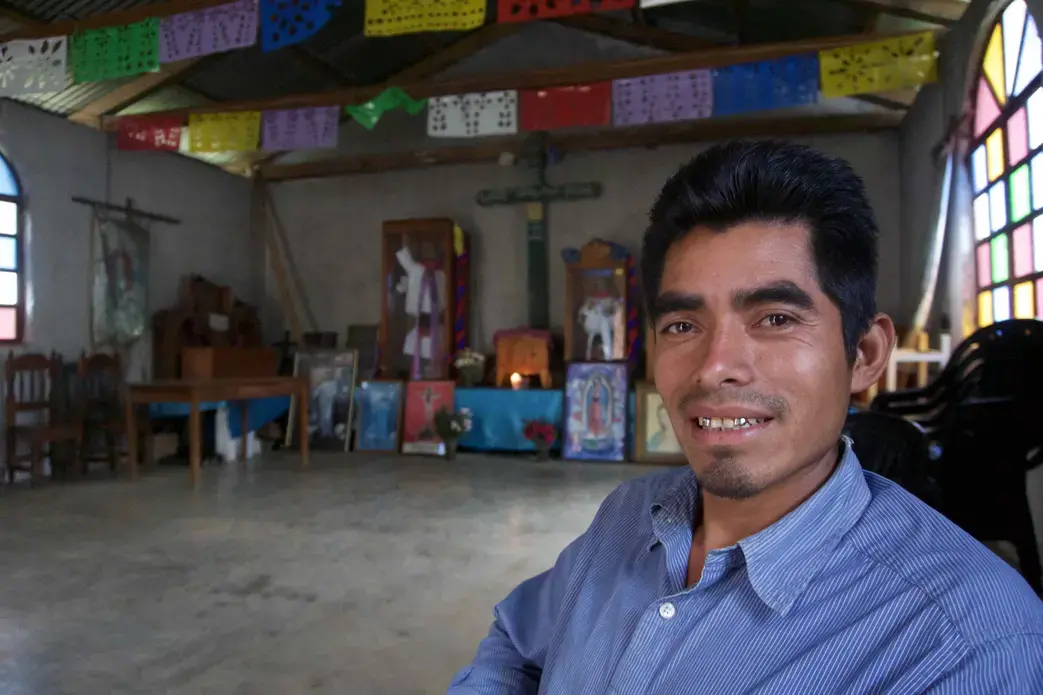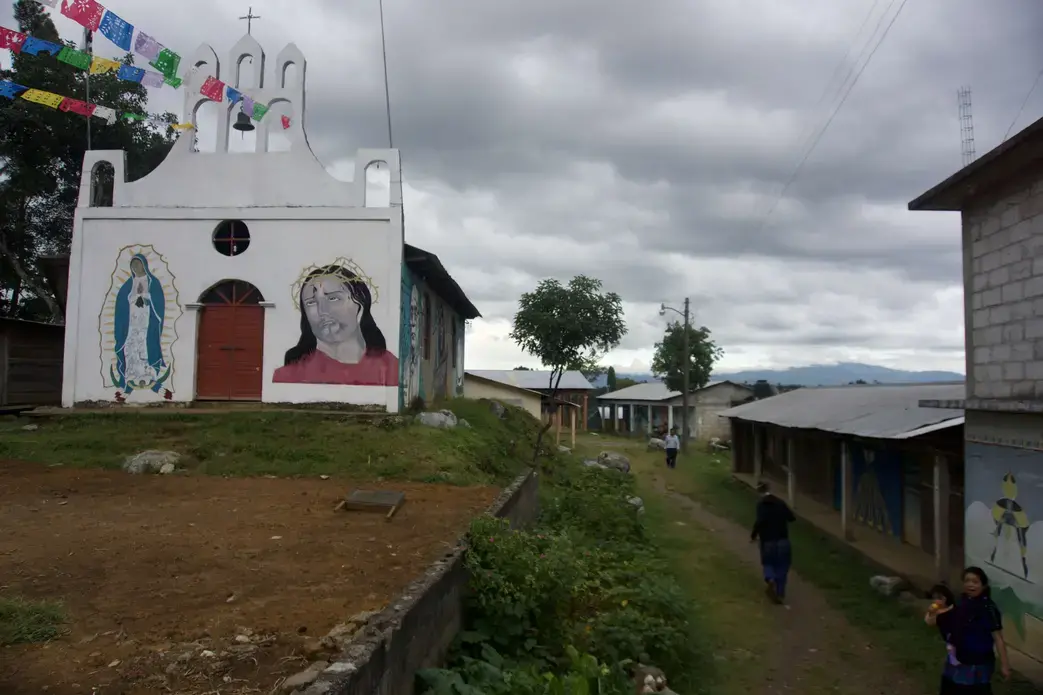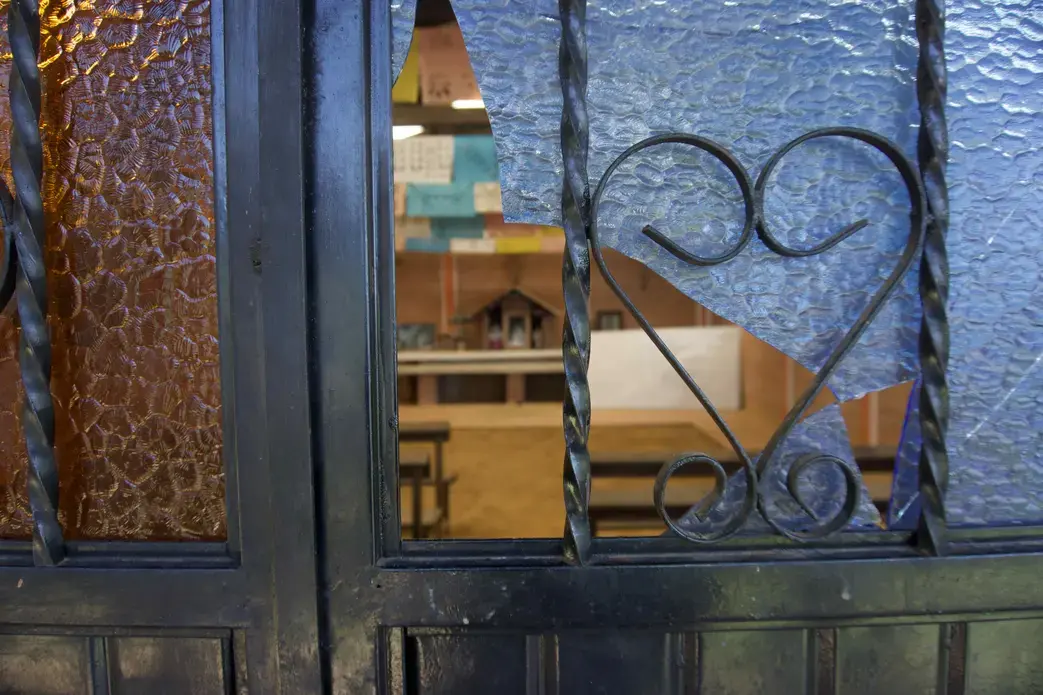Memory Defiant
One of the survivors lost his sister. Another, his entire family. A third one explains, her thin voice barely audible against the melancholy hush of mountain rain, how she was shot seven times, while she watched helplessly as the paramilitaries used bayonets to slit open the stomachs of the pregnant women around her.
"When I saw all the people around me dead," she says, "I began pleading for God to help save my life."
Seated in a spartan and empty church in the remote village of Acteal, high in the scalloping blue-green mountains of Chiapas, Mexico, three survivors of the Acteal massacre recall the gruesome details of the fateful day, nearly 21 years ago, when 49 people were murdered by a state-allied paramilitary less than 20 yards from where we now sit.
One of the bloodiest moments in Chiapas' tormented history, the Acteal massacre was the darkest embodiment of the systemic violence which has continued to haunt Mexico's southernmost state.
Carried out at the height of the Zapatista conflict, an anachronistic low-intensity war in which indigenous rebels rose up in 1994 to resist the effects of globalization, the killing was carried out by a right-wing paramilitary, or informal army, created by the Mexican military. Ostensibly formed to fight the black-masked guerrillas, the paramilitaries would go on to terrorize any civil society group that fought for social justice in Chiapas.
To this day, the Zapatistas exert a heavy presence in Chiapas, having created a pacifist political movement and come to control their own self-governed "autonomous zones" in southeastern Chiapas.
But the species of violence initiated at Acteal continues to this day as well, with disbanded but nonetheless active armed groups displacing rural campesinos at the behest of rich landowners, corporations, and narco-traffickers.
For these survivors, the morning of December 22, 1997, is a memory that's haunted them their entire lives. For the rest of Chiapas, the ghosts of that two-decade-old mass murder are still very real.
Darkening Visions
Their voices numb, the survivors in the church explain the months of deepening violence which laid the backdrop to that terrible day.
In Chenalhó, a rural department of Chiapas, the violent displacements had already begun en masse by the fall of 1997.
The paramilitaries had begun attacking communities pertaining to the Las Abejas pacifist movement—an indigenous organization which to this day shares sympathies with, but bears no connections to, the Zapatistas. And though they didn't directly associate with the EZLN (Spanish acronym for Zapatista Army of National Liberation), the fact that they had been organizing against the government was enough to set a crosshair on them.
"People on the government's side in the communities began to attack Las Abejas and the Zapatistas equally," says José Ramon Vazquez Entzín. As a teenager, he had been among the many people displaced by violence that fall. He had been lucky enough, however, to not be in Acteal on the day of the massacre.
Juan Gómez and Catarina Mendez-Paciencia were among the thousands who'd been forced to flee their homes in November and December.
As the violence escalated steadily into late December, the local Catholic catechist—an adherent to liberation theology named Juan Vazquez Gómez—called for a three-day vigil to combat the suffering.
From December 20 to the 22, thousands of people displaced by paramilitary violence from the communities of Los Chorros, Pechquil, and Yabteclum would take refuge in the quaint mountain community where Vazquez Gomez was the de facto leader. They would address the problems of those evicted from their communities and pray to God for help in these dark times. Few would've guessed that the place they thought would be a safe-haven—a village named Acteal—would become the abattoir where they'd be slaughtered.
"On the 20th," Juan Gomez says, "he (Don Alonso) invited the displaced people to the church to tell them not to worry, to assure them that God was looking after them."
Juan Vazquez Luna, now 35, was the 14-year-old son of catechist Don Alonso at the time of the massacre. He remembers how, by late 1996, both the PRI-istas and Cardenistas—both pro-government campesino groups—began threatening any communities they believed were growing too comfortable with the Zapatistas. Unbeknownst to them, the more extreme of these rural fanatics were already receiving arms and training from the Mexican government at the time.
Copious amounts of money were offered to those willing to violently attack the Zapatistas. As Richard Stahler-Sholk noted, "it had been reported that leaders of the 'Anti-Zapatista Indigenous Resistance Movement' (MIRA), a paramilitary group that operates in the jungle region, receive $1,250 a month from the state government, quite an attractive sum in an area where the going wage is $3 a day."
Vazquez Luna, Gomez, and Mendez-Paciencia were among the several thousand who'd gathered there in the steep hillside village of Acteal on December 20 to discuss a plan of action and pray to God for help.
Tensions from violent displacements had by then reached a fever-pitch. Clouds of smoke billowed up from nearby villages and the report of gunshots carried clear across the hills. Fleeing villagers poured in by the hundreds from these regions, inflating even further the number of displaced campesinos who'd crowded into Acteal.
"As kids, we were very afraid of all the gunshots from the other communities in the preceding days," Vazquez Luna says.
Towards midnight on December 22, a man came running breathlessly into Acteal with a dire warning for the villagers. The paramilitaries, he said, would be arriving at the village the following morning at around 8. They had to run, to hide: escape was now their only remaining avenue for staying alive.
His warnings were to no avail. Under the guidance of Don Alonso—who had faith that God would carry them through their dark times, and who recognized that there were few places they could've escaped to—the villagers decided to stay the night and wait out the next morning.
At 11 A.M. the next morning, after three hours of anxious waiting, Don Alonso rose before the crowds and announced that, thanks to God, the paramilitaries hadn't arrived. As Juan Gomez remembers, it was at exactly that moment when the first shots at the edge of the village rang out.
Into the Abattoir
Nearly 2,000 paramilitaries had encircled the village from its uphill flank, setting houses ablaze and firing automatic weapons into the sky as they descended upon the terrified villagers, who now frantically fled and hid among the rocks.
Gomez and Vazquez Luna were among the many boys who ran to the hillside beneath the village. There, they waited within the oppressive stillness of the forest while a cacophony of rifle-shots rent the village air above them, before they were chased for hours throughout the surrounding canyons and cloud forests by the marauding gunmen.
"For three hours, we were stuck below on the hillside," Gomez says.
Hiding there in the hillside, Vazquez Luna witnessed the execution of both his father and his mother.
The catechist Don Alonso had been among those caught in the initial flight as the informal army moved in and began summarily executing the villagers; his wife, Vazquez Luna's mother, was one of the first to be killed.
Seized with grief for having told the villagers to stay instead of attempting escape, Don Alonso reportedly stopped fleeing the blitzkrieg altogether. Arms raised in an attitude of hopelessness, he looked to the sky and cried out in pain, pleading forgiveness from God as he beheld the sight of his dead wife. Only a few seconds later, he, too, was executed via a bullet to the brain.
"When he saw that they killed his wife," Vazquez Luna recalls, "he simply got up, looked at the sky, and said 'Father! Forgive me! They (the paramilitaries) don't know what they're doing!' Immediately after, he was shot in the head."
Whereas the boys sought refuge in the hillside beneath the village, away from the advancing paramilitaries, Catarina Mendez Paciencia was among the several dozen women who dove into the church at the backside of the village.
Slowly, one by one, the paramilitaries went through the one-room building, shooting all the women in an initial rampage before lingering to fire individual shots into each one of them, seeking to ensure—ultimately without success—that no survivors would remain.
In a homicidal gesture, the paramilitaries sank the blades of their bayonets into the stomachs of the pregnant women, tearing the steaming fetuses from the wombs while the victims were still alive.
Catarina Mendez Paciencia was shot seven times during this episode of the massacre, but she played dead convincingly enough for the armed men to leave her alone as they moved along killing other women.
Mortified with horror, she struggled to remain still as the gunshots continued bursting around her, listening as the paramilitaries examined the dying bodies and pumped extra bullets into the heads of those who hadn't completely expired yet. Among those killed were her mother, who she watched die before her very eyes.
The rampage in the church was the longest moment in her entire life; the shots, she recalls, seemed to go on into eternity.
Past as Prologue
Later that night, the boys Juan Gomez and Juan Vazquez Luna fled with several dozen others to a nearby Zapatista base. Mendez Paciencia, who was one among twenty-six women who survived, was later rescued by a group dispatched to the village by the Zapatistas to look for survivors.
In the immediate aftermath of the massacre, 10,500 refugees from the municipality of Chenalhó, the living refuse of the massacre, fled to the community of Polho, declared by the Zapatistas to be an "autonomous municipality in rebellion."
In an ominous nod to the future, the government would in no time be busily working to whitewash and erase the crimes committed by its dark auxiliary. Most notoriously, government soldiers stationed nearby would take the task of removing bodies from the crime site before the inevitable arrival of the press the following morning.
"At three in the morning, the government came to clean the bodies of the dead," says Vazquez Entzín.
In another foreshadowing of the future, the government was quick to dismiss the massacre at Acteal as little more than localized intercommunal violence in which the state played no part.
Instead of prosecuting the authors of the massacre, the federal government responded by ramping up its campaign against the Zapatistas.
In the words of a Human Rights Watch World Report issued two years after the massacre, "the federal government responded by not reining in PRI (pro-government) supporters willing to use violence but by aggressively moving against EZLN supporters and international observers in Chiapas. Pro-EZLN communities known as autonomous municipalities were raided by state and federal police acting with army backup."
For the villagers of Acteal, it was clear from the beginning that the government had at the least indirectly orchestrated the massacre.
According to the National Commission for Human Rights, more than 17 state officials were directly linked to the slaughter. The same Human Rights Watch Report noted that 169 people were apprehended under international pressure, but that nearly all of those incarcerated were low-level paramilitary henchmen. As of 2014, only two of the original killers remained in prison.
"Despite what the paramilitary groups have shown… as the authors of diverse crimes," Mexican sociological researcher Adrian Galindo de Pablo wrote in 2015, "none of the three levels of government has brought them to justice, and the disarmament and breaking up of paramilitary groups continues to be a historical slope that doesn't seem to have a date of realization."
"We know well that the government formed these paramilitaries," says Vazquez Entzín.
Nearly 20 years later, the ghosts of Acteal live on.
Many of the paramilitaries convicted of the crime were surreptitiously awarded homes and small government pensions. Many of those who executed the massacre but were not convicted walk freely—often openly wielding sidearms—in neighboring villages.
"Sometimes, I get angry that the paramilitaries walk freely," Mendez Paciencia says, her words—she only speaks the Mayan Tzotzil language—translated into Spanish by a bystander. "I understand that some of them were forced by the government to do the killing. And that the true intellectual author of this massacre was the government."
Violence—of a different scale, but of the same species—continues to play itself out in Chiapas.
The former paramilitaries, and the sons of those paramilitaries, have regrouped into shadowy "neoparamilitary" groups: criminal gangs that've contracted themselves out to large landowners, narcotraffickers, and local politicians interested in resource extraction or control of geographical corridors. And the vast slush of weapons the Mexican state poured into Chiapas in the late 1990s to combat the Zapatistas dispersed indiscriminately throughout the countryside, militarizing social relations, turning even minor land disputes between villages into bloody, near battle-like affairs.
"The paramilitary groups didn't cease to act," Galindo de Pablo wrote. "Today, we can track this phenomenon (of paramilitarism) in the most important accumulation processes such as large-scale mining… which conceals and legalizes counter-insurgency mechanisms created in the past.
In September of 2017, 5,000 were forced to flee their homes in the municipalities of Chalchihuitan and Chenalho following frequent attacks via armed aggressors.
Of the September 2017 violence, Latin America in Movement reported that "the wave of violence and displacement is part of the erroneous administration of conflict that initiates with the incompetence (at multiple levels of government) in disarming paramilitary groups pertaining to Chenalhó."
The violence continued in one of its latest manifestations on April 10, 2018, the entire village of Nicolas Ruiz was forced to flee their home by a violent invasion from a neoparamilitary.
As journalist David Agren wrote, the Acteal massacre "remains a potent reminder of indigenous struggle in Chiapas, a state still suffering from widespread poverty, discrimination and political corruption."
In a way, the massacre at Acteal was not merely a culmination of violence. In its condensed extremity, it provided a distilled vision of a dismal future—the beginning of a low-intensity conflict which, today, continues to affect lives, and which has yet to be resolved.
The Past Lives On
Acteal, despite the ghosts that haunt it, is still a beautiful place. You feel as if you're on the top of the world when you walk into it: all around on the tropical horizon, blue mountain ridgelines slip away in waves, scalloping cleanly beneath the clear dome of the sky.
Against the walls of the new church at the center of the village, constructed many years after the massacre, the victims of the bloodshed stare out in the form of elaborately painted murals. Don Alonso looks out over the village that was once his own with a face as sagacious as it is sad. Further along is the face of a woman and her indignant expression—one of the many "martyrs," as they now refer to the women murdered in the church. Her eyes stare out with an unwavering and clairvoyant gaze. They haunt you.
And if you walk to the back of the village, the building where the dozens of women were killed still stands today. There is a glass window in the front door, shattered in the center at nearly eye level. And if you stare in through the hole that offers a view into the building—through the gray shards of glass and into the empty cement room where dozens of lives were consumed—one can't help but feel a profound and disquieting sadness.


!["Populated the 24th of December. Land Recovered through the blood of our fallen compañeros of the EZLN" [the Spanish acronym for the Zapatista National Liberation Army]. Image by Jared Olson. Mexico, 2018. "Populated the 24th of December. Land Recovered through the blood of our fallen compañeros of the EZLN" [the Spanish acronym for the Zapatista National Liberation Army]. Image by Jared Olson. Mexico, 2018.](/sites/default/files/07-07-18/zones1.jpg)












